Lecture Notes in Statistics
Edited by P. Bickel, P. Diggle, S. Fienberg, K. Krickeberg,
I. Olkin, N. Wermuth, S. Zeger
118
�
Springer Science+Business Media, LLC
�
Radford M. Neal
Bayesian Learning for Neural Networks
,
Springer
�
Radford M. Nea!
Department of Statistics and
Department of Computer Science
University of Toronto
Toronto, Ontario
Canada MSS IA4
ISBN 978-0-387-94724-2
DOI 10.1007/978-1-4612-0745-0
ISBN 978-1-4612-0745-0 (eBook)
CIP data available.
Printed on acid-free paper.
© 1996 Springer Science+Business Media New York
Originally published by Springer-Verlag New York, Inc. in 1996
AlI rights reserved. This work may not be translated or copied in whole or in part without the written
permission ofthe publisher Springer Science+Business Media, LLC,
except for brief excerpts in connection with reviews or scholarly analysis. Use in connection with
any form of information storage and retrieval, electronic adaptation, computer software, or by similar or
dissimilar methodology now known or hereafter developed is forbidden.
The use of general descriptive names, trade names, trademarks, etc., in this publication, even if the former
are not especially identified, is not to be taken as a sign that such names, as understood by the Trade
Marks and Merchandise Marks Act, may accordingly be used freely by anyonc.
Camera ready copy provided by the author.
9 8 7 6 5 4 3
�
Preface
This book, a revision of my Ph.D. thesis,l explores the Bayesian approach
to learning flexible statistical models based on what are known as "neural
networks". These models are now commonly used for many applications,
but understanding why they (sometimes) work well, and how they can best
be employed is still a matter for research. My aim in the work reported here
to show that a Bayesian approach to learning these models
is two-fold -
can yield theoretical insights, and to show also that it can be useful in
practice. The strategy for dealing with complexity that I advocate here
for neural network models can also be applied to other complex Bayesian
models, as can the computational methods that I employ.
In Chapter 1, I introduce the Bayesian framework for learning, the neu
ral network models that will be examined, and the Markov chain Monte
Carlo methods on which the implementation is based. This presentation
presupposes only that the reader possesses a basic statistical background.
Chapter 1 also introduces the major themes of this book, which involve
two fundamental characteristics of Bayesian learning. First, Bayesian learn
ing starts with a prior probability distribution for model parameters, which
is supposed to capture our beliefs about the problem derived from back
ground knowledge. Second, Bayesian predictions are not based on a single
estimate for the model parameters, but rather are found by integrating the
1 Bayesian Learning for Neural Networks, Department of Computer Science, Univer
sity of Toronto, 1995.
�
VI
Preface
model's predictions with respect to the posterior parameter distribution
that we obtain when we update the prior to take account of the data. For
neural network models, both these aspects present difficulties -
the prior
over network parameters has no obvious relation to any prior knowledge
we are likely to have, and integration over the posterior distribution is
computationally very demanding.
I address the first of these problems in Chapter 2, by defining classes
of prior distributions for network parameters that reach sensible limits as
the size of the network goes to infinity. In this limit, the properties of
these priors can be elucidated. Some priors converge to Gaussian processes,
in which functions computed by the network may be smooth, Brownian,
or fractionally Brownian. Other priors converge to non-Gaussian stable
processes. Interesting effects are obtained by combining priors of both sorts
in networks with more than one hidden layer. This work shows that within
the Bayesian framework there is no theoretical need to limit the complexity
of neural network models. Indeed, limiting complexity is likely to conflict
with our prior beliefs, and can therefore be justified only to the extent that
it is necessary for computational reasons.
The computational problem of integrating over the posterior distribu
tion is addressed in Chapter 3, using Markov chain Monte Carlo methods.
I demonstrate that the hybrid Monte Carlo algorithm, originally developed
for applications in quantum chromodynamics, is superior to the methods
based on simple random walks that are widely used in statistical applica
tions at present. The hybrid Monte Carlo method makes the use of complex
Bayesian network models possible in practice, though the computation time
required can still be substantial.
In Chapter 4, I use a hybrid Monte Carlo implementation to test the
performance of Bayesian neural network models on several synthetic and
real data sets. Good results are obtained on small data sets when large
networks are used in conjunction with priors designed to reach limits as
network size increases, confirming that with Bayesian learning one need
not restrict the complexity of the network based on the size of the data
set. A Bayesian approach is also found to be effective in automatically
determining the relevance of inputs.
Finally, in Chapter 5, I draw some conclusions from this work, and
briefly discuss related work by myself and others since the completion of
the original thesis.
Readers interested in pursuing research in this area may obtain free soft
ware implementing the methods, as described in Appendix B. One should
note, however, that this software is not intended for use in routine data
analysis. The software is also designed only for use on Unix systems.
�
Preface
vii
Of the many people who have contributed to this work, I would like
first of all to thank my thesis advisor, Geoffrey Hinton. His enthusiasm
for understanding learning, his openness to new ideas, and his ability to
provide insightful criticism have made working 'with him a joy. I am also
fortunate to have been part of the research group he has led, and of the
wider AI group at the University of Toronto. I would particularly like to
thank fellow students Richard Mann, Carl Rasmussen, and Chris Williams
for their helpful comments on this work and its precursors. My thanks also
go to the present and former members of my Ph.D. committee, Mike Evans,
Scott Graham, Rudy Mathon, Demetri Terzopoulos, and Rob Tibshirani.
I am especially pleased to thank David MacKay, whose work on Bayesian
learning and its application to neural network models has been an inspi
ration to me. He has also contributed much to this work through many
conversations and e-mail exchanges, which have ranged from the philos
ophy of Bayesian inference to detailed comments on presentation. I have
benefited from discussions with other researchers as well, in particular,
Wray Buntine, Brian Ripley, Hans Henrik Thodberg, and David Wolpert.
This work was funded by the Natural Sciences and Engineering Research
Council of Canada and by the Information Technology Research Centre. For
part of my studies, I was supported by an Ontario Government Scholarship.
�
Contents
Preface
1 Introduction
1.1 Bayesian and frequentist views of learning
. . .
1.1.1 Models and likelihood . . . . . .
1.1.2 Bayesian learning and prediction
1.1.3 Hierarchical models
1.1.4 Learning complex models . . . .
1.2 Bayesian neural networks . . . . . . . .
1.2.1 Multilayer perceptron networks.
1.2.2 Selecting a network model and prior
1.2.3 Automatic Relevance Determination (ARD) models
1.2.4 An illustration of Bayesian learning for a neural net
Implementations based on Gaussian approximations
1.2.5
1.3 Markov chain Monte Carlo methods . . . . . . . . . .
1.3.1 Monte Carlo integration using Markov chains .
1.3.2 Gibbs sampling. . . . . . . . .
1.3.3 The Metropolis algorithm . . .
1.4 Outline of the remainder of the book
III
1
3
3
4
6
7
10
10
14
15
17
19
22
23
25
26
28
�
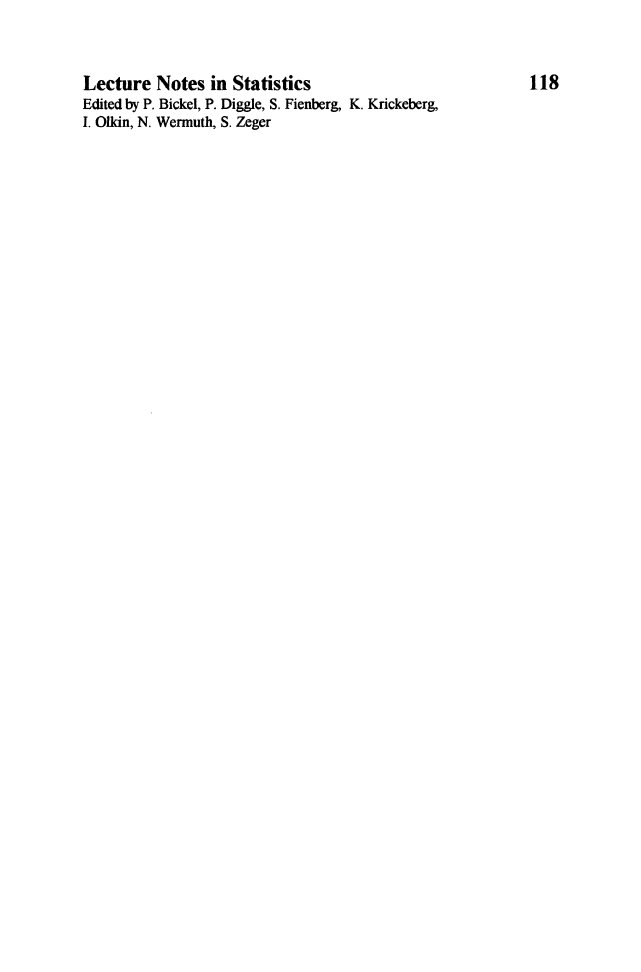



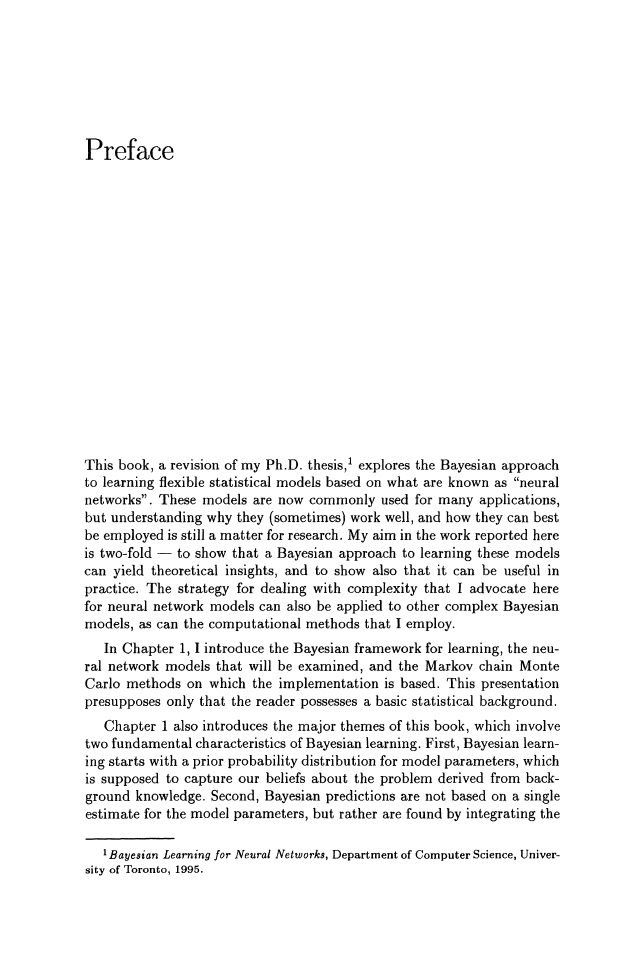
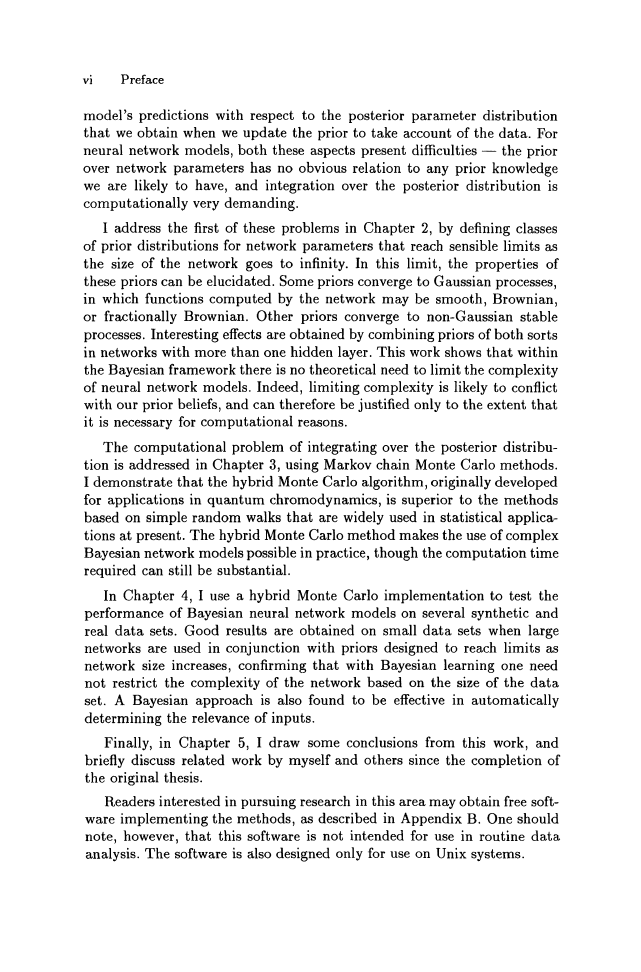
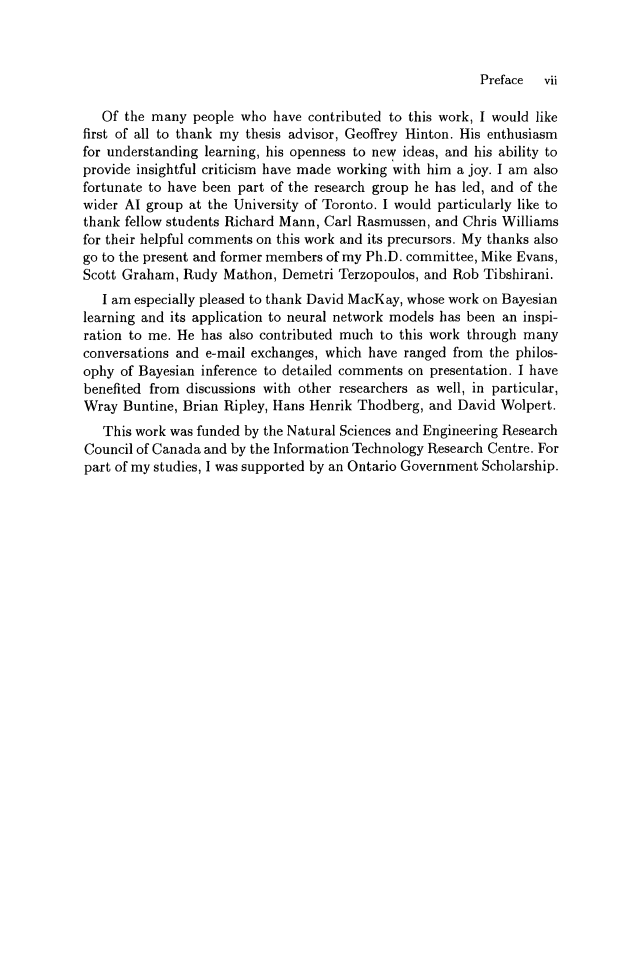
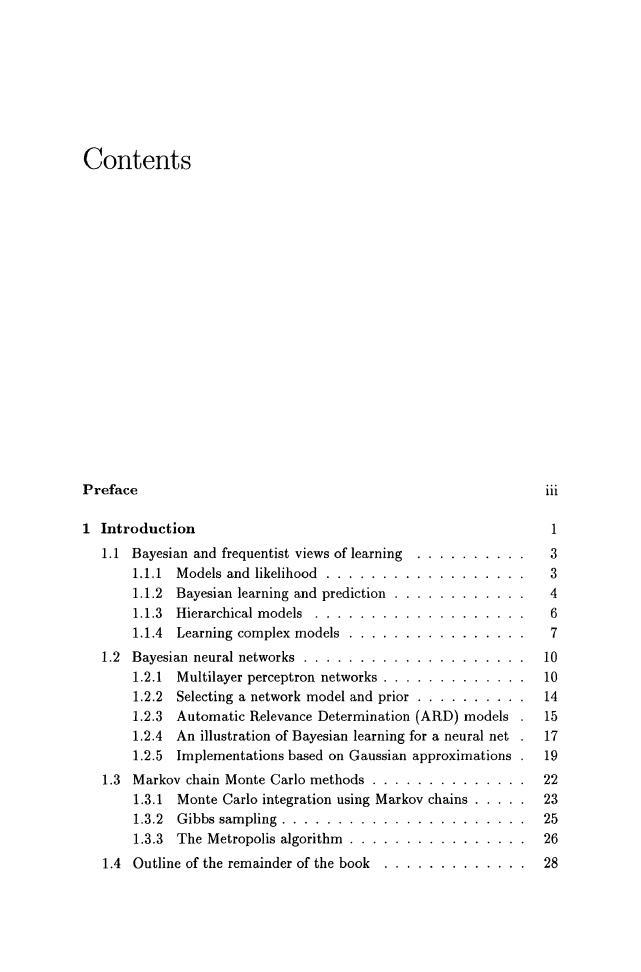








 2023年江西萍乡中考道德与法治真题及答案.doc
2023年江西萍乡中考道德与法治真题及答案.doc 2012年重庆南川中考生物真题及答案.doc
2012年重庆南川中考生物真题及答案.doc 2013年江西师范大学地理学综合及文艺理论基础考研真题.doc
2013年江西师范大学地理学综合及文艺理论基础考研真题.doc 2020年四川甘孜小升初语文真题及答案I卷.doc
2020年四川甘孜小升初语文真题及答案I卷.doc 2020年注册岩土工程师专业基础考试真题及答案.doc
2020年注册岩土工程师专业基础考试真题及答案.doc 2023-2024学年福建省厦门市九年级上学期数学月考试题及答案.doc
2023-2024学年福建省厦门市九年级上学期数学月考试题及答案.doc 2021-2022学年辽宁省沈阳市大东区九年级上学期语文期末试题及答案.doc
2021-2022学年辽宁省沈阳市大东区九年级上学期语文期末试题及答案.doc 2022-2023学年北京东城区初三第一学期物理期末试卷及答案.doc
2022-2023学年北京东城区初三第一学期物理期末试卷及答案.doc 2018上半年江西教师资格初中地理学科知识与教学能力真题及答案.doc
2018上半年江西教师资格初中地理学科知识与教学能力真题及答案.doc 2012年河北国家公务员申论考试真题及答案-省级.doc
2012年河北国家公务员申论考试真题及答案-省级.doc 2020-2021学年江苏省扬州市江都区邵樊片九年级上学期数学第一次质量检测试题及答案.doc
2020-2021学年江苏省扬州市江都区邵樊片九年级上学期数学第一次质量检测试题及答案.doc 2022下半年黑龙江教师资格证中学综合素质真题及答案.doc
2022下半年黑龙江教师资格证中学综合素质真题及答案.doc